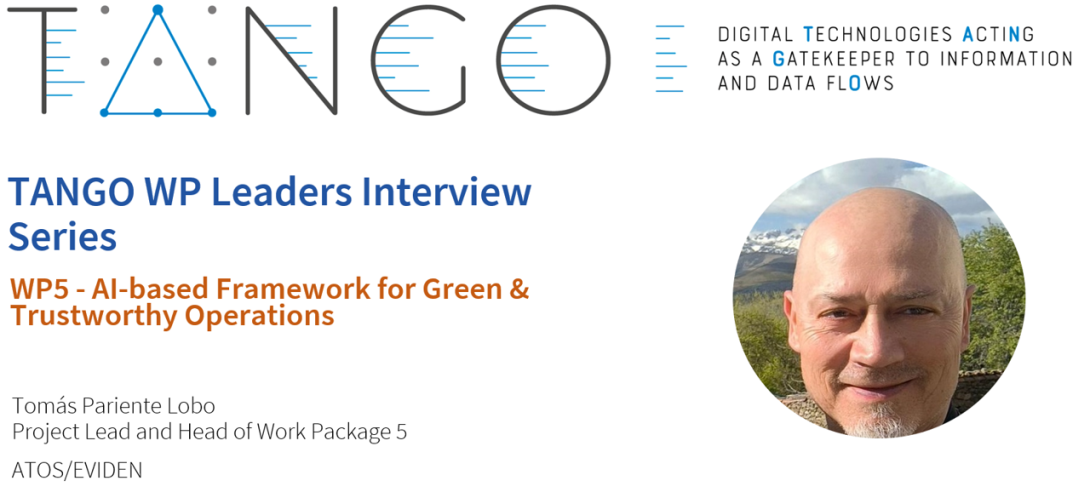TANGO WP Leaders Interview Series – WP5 AI-based Framework for Green & Trustworthy Operations

Welcome to the first part of our new TANGO WP leaders interview series, where we spotlight the partners leading work packages within the project. In this edition, we sit down with Tomás Pariente Lobo from ATOS, project lead and Head of Work Package 5 – AI-based Framework for Green & Trustworthy Operations – to discuss the challenges and exciting developments shaping TANGO’s technical journey in WP 5.
In one sentence, how would you describe the purpose of WP5?
WP5 aims to provide a set of tools to support several aspects of the AI life cycle, with a focus on green or energy-efficient operations, as well as tackling privacy risk assessment.
Which WP5 tool or component have you found most useful, and why?
There are several tools that are useful for different use cases. If users are interested in risk assessment, PEC (Policy Enforcement Point) and PAT (Privacy Assurance Tool) are key. If they would like to perform exploratory data analysis of the data shared via the TANGO platform, then EDAE (Exploratory Data Analysis Engine) is core to this process, enhanced optionally with TornadoVM to accelerate the underlying hardware and reduce the processing footprint. For Machine Learning (ML) training, a combination of tools such as Federated Learning, XAI (Explainable Artificial Intelligence) and MLOps (Machine Learning Operations) can help users to track their experiments and ensure trustworthiness in the models. RENOPS (Renewable Energy Forecast Production Service) can be also used standalone or in combination with the above-mentioned tools to schedule heavy training jobs at times or locations where renewable energy is available, reducing costs and/or carbon footprint.
What benefits have you seen from using WP5 tools?
WP5 tools do not replace existing efforts and tools in the AI community; rather they offer a set of techniques and tools that might help data scientists and ML practitioners to bootstrap the work on data shared via the TANGO platform. Therefore, TANGO users will have tools for AI privacy assessment, data preprocessing and analysis, ML training and explainability in a single place, as well as means to reduce carbon footprint, which are easily integrated with the training phase via MLOps and RENOPS.
How did you approach privacy, explainability, or energy efficiency in your AI models using WP5?
We developed specific modules for explainability (XAI) and incorporated MLOps techniques for traceability of experiments with AI models that help on the trustworthiness of the experiments. Users may make use of the MLOps environment to easily invoke XAI and RENOPS (examples are provided to show the synergies of these components). EDAE also relies on the TornadoVM for faster and more sustainable operations over the underlying hardware.
Which WP5 technologies impressed you most from a technical perspective?
The work on TornadoVM on hardware acceleration is quite impressive. PAT has proven to be very flexible, helping for instance to get personal information in the hotel check-in process in a privacy-preserving way. The Federated Learning framework is also a new tool that may reach a high Technology Readiness Level (TRL).
Which WP5 tools seemed to engage end users the most across the pilots?
EDAE is widely used in several pilots, producing interesting reports about the data for end users.
What has WP5 taught you about balancing AI performance with privacy and energy demands?
It Is hard to get that balance, especially now that LLMs tend to consume a lot of energy. The solution lies in adopting different perspectives, such as reducing the footprint of the training phase, thinking in lighter models, and searching for clever ways to move computation to more environmentally friendly settings or times. This is just one work package within a whole project, but more focused research on frugal AI should be conducted in future dedicated projects.
What’s one technical challenge you faced while working with WP5 tools — and how did you overcome it?
The project was focused on operations over data spaces, but AI cannot be restricted to operating only on data shared in a data space. Other data (in-house proprietary data, open data, etc.) should be combined with the data gathered from a data space. Therefore, a decision was made for some of the tools not to integrate tightly with the data space connectors, but rather to operate outside it with the data available to the data scientist. This decision took some time and drove some architectural choices from the WP5 perspective.